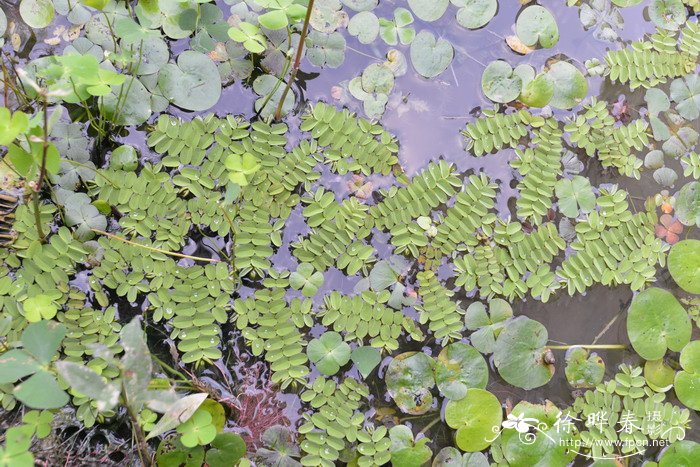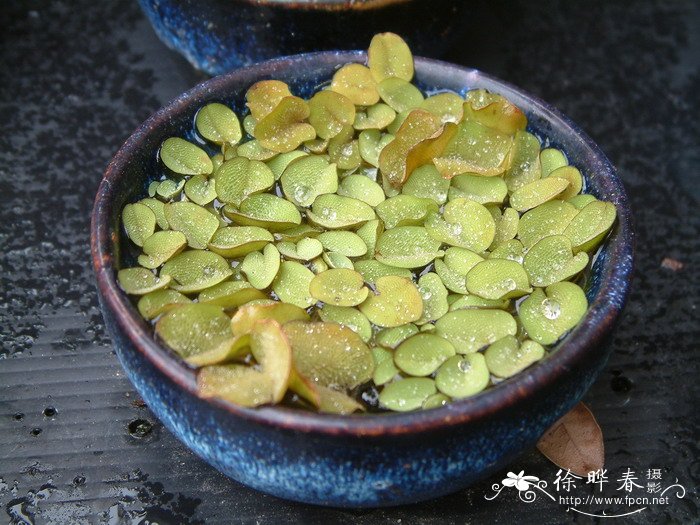槐叶苹Salvinia natans
中文名(Chinese Name):槐叶苹
学名(Scientific Name): Salvinia natans (Linn.) All.
英文名(English Common Name):
别名(Chinese Common Name):槐叶萍,槐叶苹蘋
异名(Synonym):
科属(Family & Genus):槐叶蘋科Salviniaceae槐叶蘋属Salvinia
形态特征(Description):小型漂浮植物。茎细长而横走,被褐色节状毛。三叶轮生,上面二叶漂浮水面,形如槐叶,长圆形或椭圆形,长0.8-1.4厘米,宽5-8毫米,顶端钝圆,基部圆形或稍呈心形,全缘;叶柄长1毫米或近无柄。叶脉斜出,在主脉两侧有小脉15-20对,每条小脉上面有5-8束白色刚毛;叶草质,上面深绿色,下面密被棕色茸毛。下面一叶悬垂水中,细裂成线状,被细毛,形如须根,起着根的作用。孢子果4-8个簇生于沉水叶的基部,表面疏生成束的短毛,小孢子果表面淡黄色,大孢子果表面淡棕色。
分布(Distribution):广布长江流域和华北、东北以及远到新疆的水田中,沟塘和静水溪河内。日本、越南和印度及欧洲均有分布。
用途(Use):全草入药,煎服,治虚劳发热,湿疹,外敷治丹毒,疗疮和烫伤。
引自中国植物志英文版:FOC Vol. 2-3 Page 125
Salvinia natans (Linnaeus) Allioni, Fl. Pedem. 2: 289. 1785.
槐叶苹 huai ye ping| Salviniaceae | Salvinia
Marsilea natans Linnaeus, Sp. Pl. 2: 1099. 1753.
Floating fronds sessile or with stipe to ca. 1 mm; lamina Robinia-shaped, 0.8-1.4 × 0.5-0.8 cm, base rounded or subcordate, margin entire, apex obtuse; lateral veins 15-20 on each side of costa, each one with 5-8 low dome-shaped papillae, each with a terminal bunch of ca. 4 white setae; lamina deep green on upper surface, densely brown villous on lower surface; submersed fronds finely dissected into linear segments, covered with hairs, and acting as roots. Sporocarps 4-8, clustered at bases of submersed fronds, with sparse bunches of hairs; microsporocarps yellowish, megasporocarps brownish.
Floating on rice fields, ponds, ditches. Throughout most of China, widely distributed along the Chang Jiang [India, Thailand, Vietnam; Africa, Asia, Europe].
The whole plant is used medicinally; it is boiled and eaten for "consumptive disease" and eczema and externally used for inflammatory diseases affecting the skin.
The name Salvinia natans has been misapplied to plants in North America (S. minima Baker).


(责任编辑:徐晔春)
学名(Scientific Name): Salvinia natans (Linn.) All.
英文名(English Common Name):
别名(Chinese Common Name):槐叶萍,槐叶苹蘋
异名(Synonym):
科属(Family & Genus):槐叶蘋科Salviniaceae槐叶蘋属Salvinia
形态特征(Description):小型漂浮植物。茎细长而横走,被褐色节状毛。三叶轮生,上面二叶漂浮水面,形如槐叶,长圆形或椭圆形,长0.8-1.4厘米,宽5-8毫米,顶端钝圆,基部圆形或稍呈心形,全缘;叶柄长1毫米或近无柄。叶脉斜出,在主脉两侧有小脉15-20对,每条小脉上面有5-8束白色刚毛;叶草质,上面深绿色,下面密被棕色茸毛。下面一叶悬垂水中,细裂成线状,被细毛,形如须根,起着根的作用。孢子果4-8个簇生于沉水叶的基部,表面疏生成束的短毛,小孢子果表面淡黄色,大孢子果表面淡棕色。
分布(Distribution):广布长江流域和华北、东北以及远到新疆的水田中,沟塘和静水溪河内。日本、越南和印度及欧洲均有分布。
用途(Use):全草入药,煎服,治虚劳发热,湿疹,外敷治丹毒,疗疮和烫伤。
引自中国植物志英文版:FOC Vol. 2-3 Page 125
Salvinia natans (Linnaeus) Allioni, Fl. Pedem. 2: 289. 1785.
槐叶苹 huai ye ping| Salviniaceae | Salvinia
Marsilea natans Linnaeus, Sp. Pl. 2: 1099. 1753.
Floating fronds sessile or with stipe to ca. 1 mm; lamina Robinia-shaped, 0.8-1.4 × 0.5-0.8 cm, base rounded or subcordate, margin entire, apex obtuse; lateral veins 15-20 on each side of costa, each one with 5-8 low dome-shaped papillae, each with a terminal bunch of ca. 4 white setae; lamina deep green on upper surface, densely brown villous on lower surface; submersed fronds finely dissected into linear segments, covered with hairs, and acting as roots. Sporocarps 4-8, clustered at bases of submersed fronds, with sparse bunches of hairs; microsporocarps yellowish, megasporocarps brownish.
Floating on rice fields, ponds, ditches. Throughout most of China, widely distributed along the Chang Jiang [India, Thailand, Vietnam; Africa, Asia, Europe].
The whole plant is used medicinally; it is boiled and eaten for "consumptive disease" and eczema and externally used for inflammatory diseases affecting the skin.
The name Salvinia natans has been misapplied to plants in North America (S. minima Baker).
(责任编辑:徐晔春)
踩一下[1]

顶一下[7]